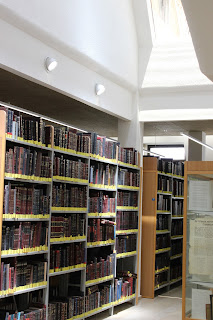Shavuot and the Resilience of our Torah
Aharon Bejell
Head Librarian
Yeshivat Har Etzion Torah Library
The unique
character of Shavuot, as Zman Matan Torateinu, expresses itself by
connecting us to a most meaningful event, whose strength is found in its being
a one-time event, which has never been repeated.
This is
clearly pointed out by Moshe Rabbeinu, in Sefer Devarim, in his description of
the resounding voice of G-d which was heard during the revelation at Har Sinai.
"קול גדול ולא יסף" (דברים ה:יח)
The straightforward usage of לא יסף means
that the voice of G-d will not continue to resound as it did at that time and
place (i.e: לא הוסיף). This is how the Ibn Ezra explained
it: "as it was for that one occasion only".
In contrast to the peshat, Unkelos
and Rashi explain it as just the opposite, "לא פסק", meaning that it did not cease to resound: "as the
voice of G-d is powerful and everlasting".
Even if we choose the second
explanation, this does not mean that we actually perceive that the voice of G-d
continues to resound and reveal itself until this very day, as it did at Sinai. We must assume that the message here is that there is a dimension of G-d's
voice which appears in each generation, to those who deeply engage themselves
in learning the Torah, and it is as if they hear the echo of G-d's voice
reaching their ears from Har Sinai. Engagement with the Torah, motivated by the
belief that Torah continues to be relevant in every generation, achieves this
goal and provides us with the necessary tools to confront the new challenges
which constantly meet us on our way.
Shavuot is not only a romantic
attempt to re-experience the one-time event at Har Sinai, when G-d's voice
resounded in our ancestors' ears. This holiday is an opportunity for us to hear
the voice of G-d vibrating from the Torah that we learn and teach, and in this
way to relate to the Torah as a fresh and exciting expression of G-d's word,
relevant as always, even to our generation.
As our
sages put it: "אשר אנכי מצוך היום"
"The words of the Torah
should be perceived by you every day as something new, as if you first received
them today at Sinai".
At Yeshivat Har Etzion we have
succeeded in creating a Beit Midrash which strives for excellence in Talmud
Torah, and the medium for that is intensive and deep learning. The direction
and guidance that we receive at the yeshiva demand from us to work hard in our
Torah studies and let them empower us to move forward into the complexities and
dynamics of modern life, as the bearers of the voice of G-d which we have
revealed through our Torah.
The Grand Torah library, which
resides in the foothills of the Beit Midrash, and was developed as part of the
educational vision of the yeshiva, provides us with open access to a diverse
Torah literature, the fruits of intense, multi-generational, Torah study. In
all areas of interest, the library's collection weaves tried and tested Torah
literature with new expressions of Torah learning and scholarship, providing us
with a clear view of the Torah's ongoing process of renewal in our generation. At the same time, by giving the rare and antique collections a prominent place amidst the vibrant collection of new works, we
are able to sense the power of the spirit of our ancestors, who continued to
devote themselves to Torah in every generation and in every place. By
experiencing our library one can clearly understand that what we are doing in
our generation, to renew our bond with the Torah, is a continuation of what was
done in every generation before us.
It was a deep appreciation of Torah
which motivated previous generations to take advantage of the new printing
technologies in order to spread Torah literature and to guarantee the existence
of the Jewish people. They understood that the resilience of Am Yisrael was
dependent on the renewal and continued relevance of the Torah. The spectrum of
Torah literature which they left behind them is a combination of new editions
of Torah classics and new works in all areas of Torah. This was their way to
provide the young generation with a fresh and intellectually challenging Torah,
which confronted the needs of the changing times while retaining the devotion
to the traditions of our fathers. By doing so they paved the way before us, and
in our generation we have also taken advantage of the internet and new
information technologies in order to spread and renew our Torah. It is exactly
the same principle, the voice of G-d resounding in our ears as we learn,
energizes us to continuously renew the Torah.
The next time you visit The Gush Torah Library,
don't relate to it as just a storage room of books, and don't relate to the
books as just simple paper and ink. As you deeply engage yourself in Torah
study, open your ears to hear G-d's resounding voice calling out to you "אנכי ה' א-לקיך".


























